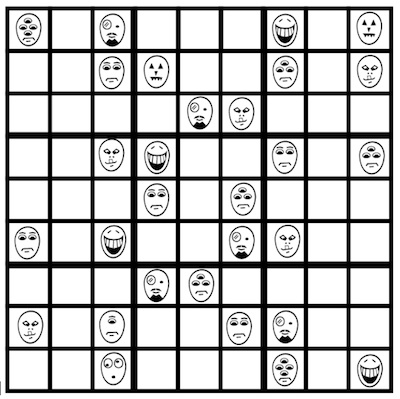Sometimes with maths, it is a case of it's all Latin to me
by Burkard Polster and Marty Ross
The Age, 27 August 2007

Suduko is the biggest mathematical puzzle craze since Rubik's Cube. But is it really mathematical?
In a sudoku puzzle, some numbers are placed in a 9x9 grid, and then the puzzler must fill the grid: each row, each column and the obvious 3x3 subsquares must contain the numbers from 1 to 9. So, there are numbers involved, but it is easy to see that this is not essentially mathematical. We could replace the numerals 1 through 9 by any nine distinct symbols and we would have exactly the same puzzle.
But, if the use of numerals is optional, there is still plenty of mathematics to be found. In solving a sudoku puzzle, we consider the myriad ways of placing symbols in a grid. This involves the permutations of the symbols, a branch of mathematics known as Combinatorics. Mathematicians are keenly interested in a version of sudoko puzzle, where each row and each column must contain all symbols, but there is no demand that subsquares behave in a certain manner. These are called Latin Squares, a name dating back over two hundred years, to the great mathematician Leonhard Euler. Euler called them Latin squares simply because he used Latin characters as his symbols.
Ian Wanless, a mathematician at Monash University, is an expert on Latin squares. Ian’s webpage (http://cs.anu.edu.au/~imw/) lists a number of the Latin square questions mathematicians would most like to answer. Most obviously, exactly how many Latin squares are there? For example, if we look at 9x9 Latin squares there are 5,524, 751,496,156,892,842,531,225,600 of them, of which 6,670,903,752,021,072,936,960 are sudoku.
You can always rotate or reflect a Latin square, or shuffle its entries, giving a new one. But this ‘new’ Latin square is essentially the same. There are in fact 377,597,570,964,258,816 essentially different 9x9 Latin squares, of which 5,472,730,538 are sudoku. So, if you solve one different puzzle for each sudoku, completing one per minute, then you have enough puzzles to last ten thousand years. Enjoy.
But what if we change the size of the square? The number of 10x10 Latin squares is also known, and recently Ian and his ANU colleague Brendan McKay determined the number of 11x11 Latin squares (see Ian’s webpage for the very long answer). But no one knows the number of 12x12 Latin squares, or anything beyond. Mathematicians would love a simple formula for the number of n x n Latin squares. That would really be a puzzle worth solving!
Copyright 2004-∞ ![]() All rights reserved.
All rights reserved.